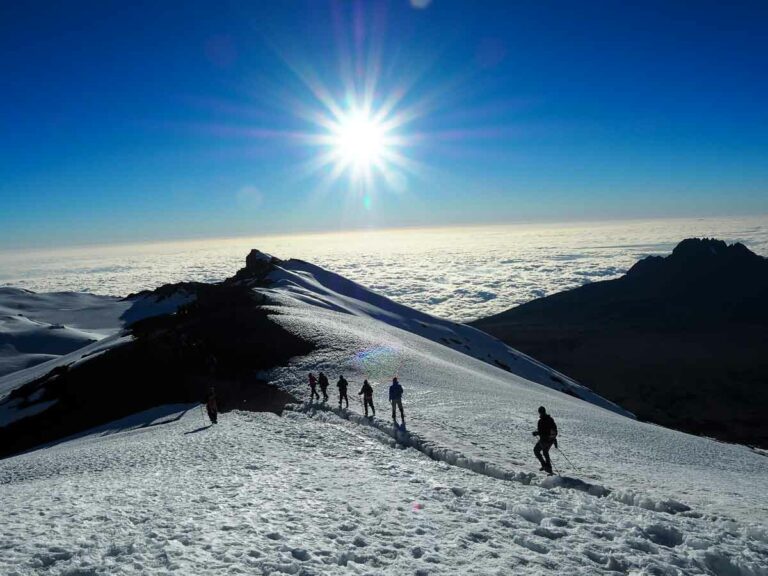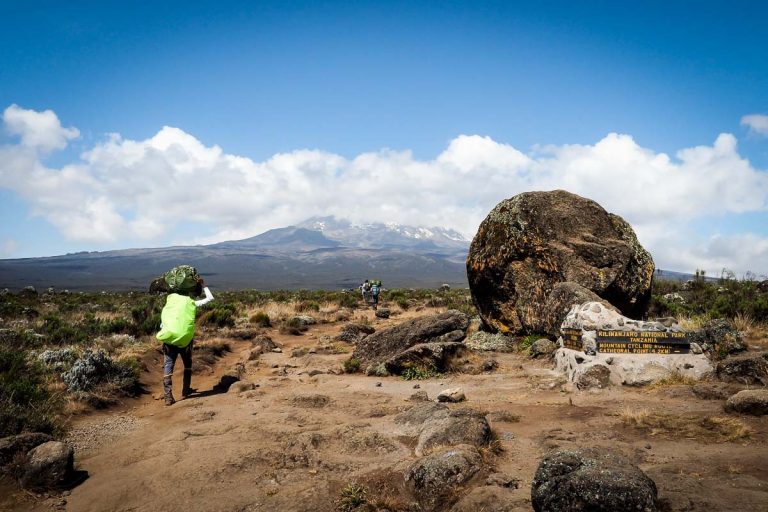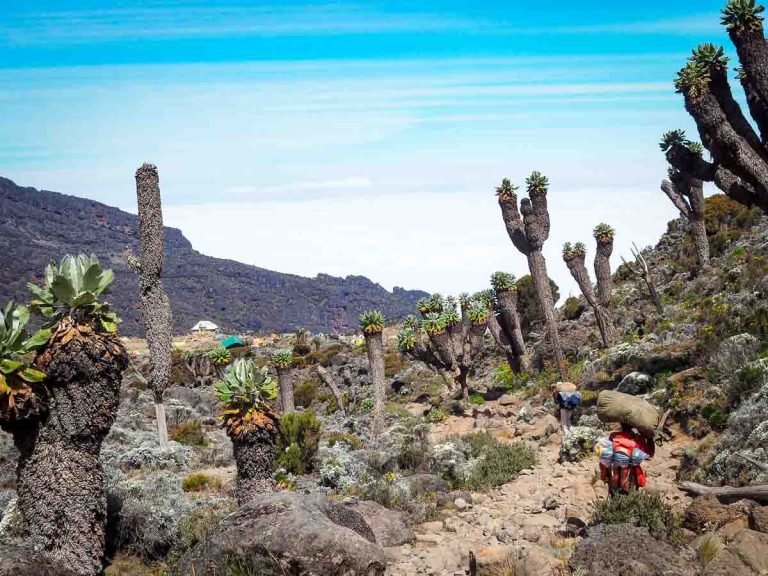What to Pack to Climb Mount Kilimanjaro (My List)
Climbing Mount Kilimanjaro is a once-in-a-lifetime experience that requires careful planning and preparation, especially when it comes to packing. The right gear can make all the difference in ensuring a safe and enjoyable climb.
In this guide, I’ll share what I packed, or what I wished I had packed when I climbed Kilimanjaro.
Here is an outline of what to pack for a successful Kilimanjaro climb:
Pic For Attention: Here’s a photo from a trekking company’s office. This is what they’re taking (so you don’t have to!)
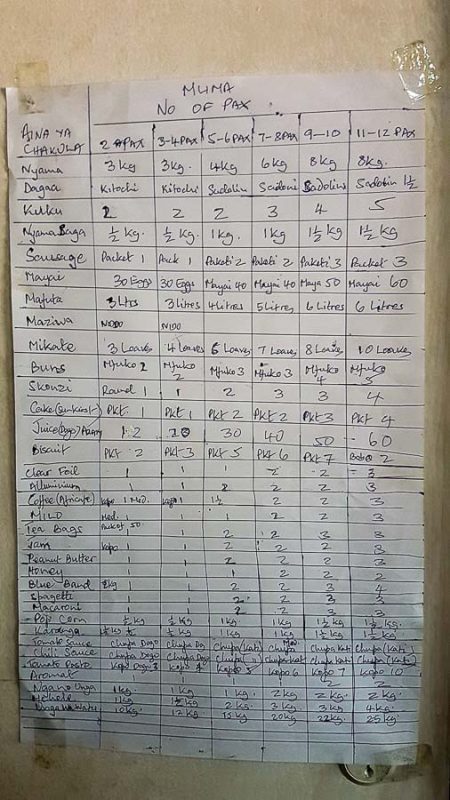
Table of Contents
1. A Good Layering System (Most Important)
A well-designed layering system is essential for a successful Kilimanjaro climb. Base layers should be moisture-wicking and breathable to keep you dry and comfortable. Mid-layers should provide insulation and warmth, while outer layers should be waterproof and windproof.
For a high-quality base layer, I always recommend Icebreaker as they use 100% New Zealand Merino wool for its breathability, low odor, and moisture-wicking properties. The Ice Breaker Oasis 260 (or similar) is a good, versatile base layer.

Men’s Merino 260 Tech Long Sleeve
(Best Well-Designed Icebreaker for Kilimanjaro)
Pros
Cons
2. Insulated Jacket
An insulated jacket is a must-have for the colder weather on Kilimanjaro. I recommend the Patagonia Men’s Tres 3-in-1 Parka, which is versatile and can be worn as a waterproof shell, insulated jacket or both. It is made with recycled materials and is both warm and durable.

Men’s Merino 260 Tech Long Sleeve
(Best Insulated Jacket for Kilimanjaro)
Pros
Cons
3. Waterproof and Windproof Jacket and Pants
A waterproof and windproof jacket and pants are essential to keep you dry and protected from the elements. I recommend the Arc’teryx Men’s Beta AR Jacket and Arc’teryx Men’s Beta AR Pants. They are both made with high-quality Gore-Tex fabric, which is waterproof and breathable.
4. Warm Hat, Gloves, and Socks
A warm hat, gloves, and socks are crucial for keeping you warm and comfortable on the mountain. We recommend the Outdoor Research Men’s Stormtracker Heated Gloves which are heated, waterproof and durable. For socks, I recommend the Darn Tough Men’s Mountaineering Extra Cushion Socks. They are made of high-quality merino wool and are both warm and moisture-wicking.
5. Gaiters (Not essential, but recommended)
Gaiters are essential for keeping snow and debris out of your boots. Now, you don’t need these (i didn’t wear mine) BUT you will spend 8 days extracting gravel from your boots if you don’t. The loose scoria finds its way in everywhere, so I’d take these if you have a pair.
I recommend the Outdoor Research Men’s Crocodile Gaiters which are made of durable and waterproof fabric.
6. Hiking Boots
I’m normally a laise faire hiker..
a ‘footware is optional’ kind of hiker.
But when you’re in Africa, 6000m above sea-level and stuck on a volcano for a week, you need footwear you can trust.
I recommend the Salomon Men’s X Ultra 3 Mid GTX Hiking Boots which are waterproof, breathable and provide excellent ankle support.
7. Trekking Poles
For trekking poles, I recommend the Black Diamond Trail Pro Shock Trekking Poles which are lightweight, durable and have a shock-absorbing system.

Black Diamond Trail Pro Shock Trekking Poles
(Best Trekking Poles for Kilimanjaro)
Pros
Cons
7. Sunglasses and Sunhat
Sunglasses and a sunhat are essential for protecting your eyes and skin from the harsh sun on Kilimanjaro. We recommend the Julbo Explorer 2.0 Sunglasses which are designed for high-altitude mountaineering and provide excellent protection from the sun’s harmful rays. For a sunhat, we recommend the Outdoor Research Sun Runner Cap which has a built-in UPF 50+ sun protection and can be worn in different ways for added versatility.

Julbo Explorer 2.0 Sunglasses
(Best Sunglasses for Kilimanjaro)
Pros
Cons
8. Sleeping bag
Ok, so you don’t necessarily need to bring sleeping gear. Your trekking company can provide (some will charge extra for this) the sleeping mat and bag you need. BUT.. bringing your own will ensure you get good, CLEAN, and well looked after gear
I opted to hire my sleeping gear from the treking company. I was flying cary-on only so didn’t have room to bring a sleeping bag. In hindsight, I wish I brought my own as the one I got wasn’t very warm and smelt like it needed a clean.. lol.
A high-quality sleeping bag is a must-have for a successful Kilimanjaro climb, especially when temperatures drop below freezing at night. We recommend the Marmot Trestles Elite Eco 20 Sleeping Bag, which is made with recycled materials and is both warm and lightweight. It is rated to 20°F (-7°C), which is more than enough for Kilimanjaro.
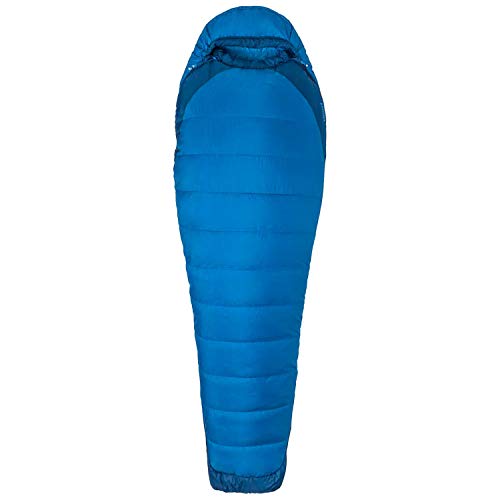
Marmot Trestles Elite Eco 20 Sleeping Bag
(Best High-Quality Sleeping Bag for Kilimanjaro)
Pros
Cons
9. Sleeping pad
A comfortable and well-insulated sleeping pad is essential for a good night’s sleep on Kilimanjaro. I have a Therm-a-Rest Air Mattress, which is lightweight, compact and provides excellent insulation. It has an R-value of 6.9, which makes it suitable for even the coldest nights on Kilimanjaro.

Therm-a-Rest NeoAir XTherm MAX Ultralight Backpacking Air Mattress
(Best High-Quality Sleeping Pad for Kilimanjaro)
Pros
Cons
10. Pillow (optional)
While a pillow is not essential for a successful Kilimanjaro climb (I actually just use my backpack wrapped in a jumper) but it can make a big difference in your comfort level and anything that helps you sleep better is money well spent in my books~
I recommend the Sea to Summit Aeros Pillow Premium, which is lightweight, compact and provides excellent support for your head and neck. It can be inflated to the perfect firmness and has a soft, brushed exterior for added comfort.
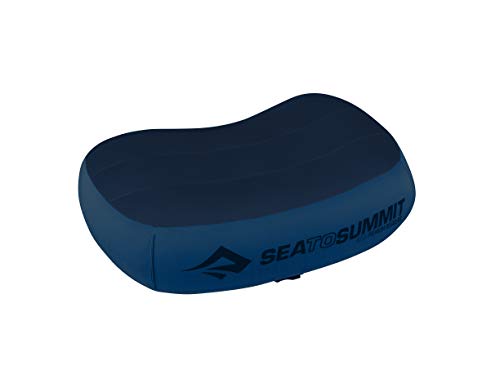
Sea to Summit Aeros Pillow Premium
(Best Premium Pillow for Kilimanjaro)
Pros
Cons
11. Water bottles or hydration system
Staying hydrated is crucial for a successful Kilimanjaro climb. I recommend bringing a hydration system such as the Osprey Hydraulics LT Reservoir or water bottles such as the Nalgene Wide Mouth Water Bottle. Both options are lightweight, durable, and easy to use.
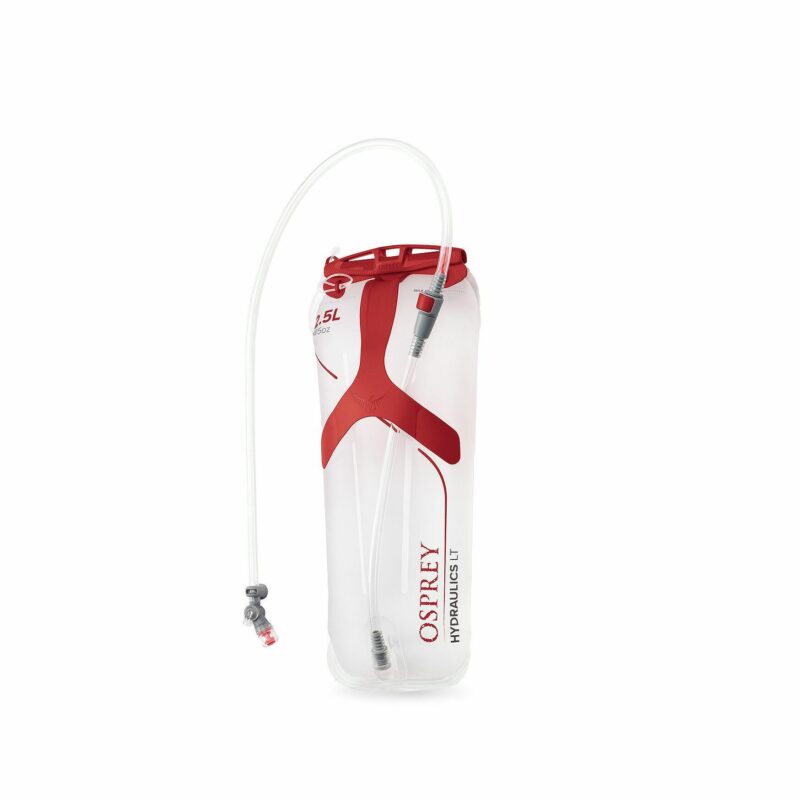
Osprey Hydraulics LT Reservoir
(Best Hydration System for Kilimanjaro)
Pros
Cons
12. Water purification tablets or a water filter
Water sources on Kilimanjaro are not always reliable, so it’s essential to bring a water purification system. Your guides SHOULD boil water at your camp each night which is then used to fill drink bottles for the next day. This is great, but i hate to feel dependant on others soprefer to be able to treat street water myself.
It also means i can drink heaps and refill along the way!
I recommend bringing water purification tablets such as Potable Aqua Water Purification Tablets or a water filter such as the Sawyer Products MINI Water Filtration System. Both options are lightweight, compact, and effective for removing bacteria and viruses from water.

Sawyer Products MINI Water Filtration System
(Best Water Purification System for Kilimanjaro)
Pros
Cons
13. High-energy snacks
Having high-energy snacks is crucial for maintaining your energy levels during the climb. I recommend bringing a variety of snacks such as energy bars, gels, and nuts. One of my favorite energy bars is the Clif Bar Energy Bar. They are made with organic ingredients and come in a variety of flavors to suit your taste. Nuts are also a great snack to bring because they are high in protein and healthy fats. I recommend bringing a mix of almonds, cashews, and peanuts.

Clif Bar Energy Bar
(Best High-Energy Snacks for Kilimanjaro)
Pros
Cons
14. Electrolyte tablets
Staying hydrated is crucial for a successful Kilimanjaro climb, but it’s also important to replenish your electrolytes. Electrolyte tablets or powder can be added to your water to help replace the minerals lost through sweat. I recommend the Nuun Sport Electrolyte Tablets which are low in sugar and provide a balance of electrolytes to keep you hydrated and energized. They come in a variety of flavors and are easy to use on the go.

Nuun Sport Electrolyte Tablets
(Best Electrolyte Tablets for Kilimanjaro)
Pros
Cons
15. Headlamp or flashlight with extra batteries
A headlamp or flashlight is essential for navigating Kilimanjaro in the dark. I recommend the Black Diamond Spot Headlamp which is lightweight, waterproof, and has a long battery life. Don’t forget to bring extra batteries just in case.
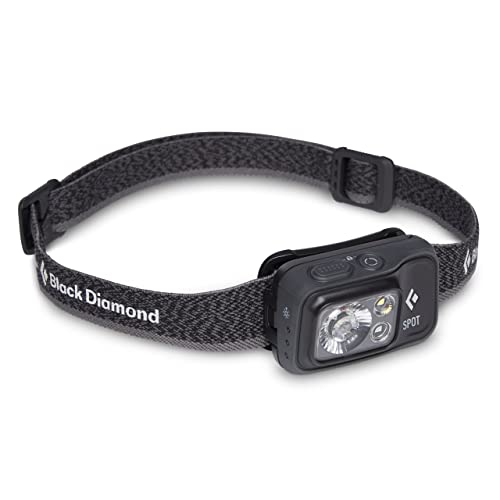
Black Diamond Spot Headlamp
(Best Headlamp for Kilimanjaro)
Pros
Cons
16. Personal first aid kit and medications
A personal first aid kit can be a lifesaver on Kilimanjaro. I recommend the Adventure Medical Kits Ultralight/Watertight .7 Medical Kit, which is compact, waterproof, and contains essential medical supplies for a range of injuries and illnesses.

Adventure Medical Kits Ultralight/Watertight .7 Medical Kit
(Best Personal First Aid Kit for Kilimanjaro)
Pros
Cons
17. Sunscreen and lip balm
The sun can be intense on Kilimanjaro, so it’s essential to bring sunscreen and lip balm to protect your skin. I recommend the Sun Bum Original SPF 30 Sunscreen Lotion which is reef-friendly, water-resistant, and provides broad-spectrum UVA/UVB protection. For lip balm, I recommend the Badger Balm Classic Lip Balm which is organic, moisturizing, and has a pleasant scent.
18. Insect repellent
Insects can be a nuisance on Kilimanjaro, so it’s important to bring insect repellent. I recommend the Sawyer Products Premium Insect Repellent with 20% Picaridin which is effective against mosquitoes, ticks, and other biting insects. It is also fragrance-free and safe for use on clothing and gear.

Sawyer Products Premium Insect Repellent with 20% Picaridin
(Best Insect Repellent for Kilimanjaro)
Pros
Cons
19. Camera and extra batteries
A camera is a must-have for capturing the incredible scenery on Kilimanjaro. I recommend the Sony Alpha a6000 Mirrorless Digital Camera which is lightweight, compact, and easy to use. Don’t forget to bring extra batteries and a charger to keep your camera powered up.

Sony Alpha a6000 Mirrorless Digital Camera
(Best Camera for Kilimanjaro)
Pros
Cons
20. Portable charger for electronics
A portable charger is essential for keeping your electronics powered up on Kilimanjaro. I recommend the Anker PowerCore 10000 Portable Charger which is lightweight, compact, and has enough power to charge a smartphone several times.
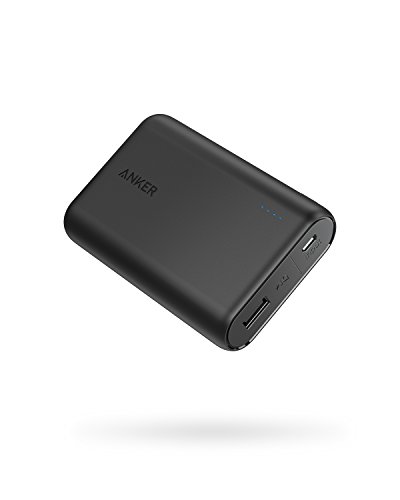
Anker PowerCore 10000 Portable Charger
(Best Portable Charger for Kilimanjaro)
Pros
Cons
21. Cash for tipping guides and porters
Tipping your guides and porters is customary on Kilimanjaro and is a way to show your appreciation for their hard work. I recommend bringing enough cash to tip each member of your team generously.
It’s also a good idea to ask your tour company for guidance on how much to tip or read this guide where I share my thoughts on how much you should be tipping
Conclusion
Remember, the key to a successful Kilimanjaro climb is to pack light and pack smart. Stick to the essentials and make sure everything you bring is high-quality and durable. Happy climbing!
Tanzania Travel Planning Cheatsheet 🇹🇿
🚑 Should I buy travel insurance for Tanzania?
100% YES! — Tanzania has now introduceed “free” healthcare but it’s only for citiens! Tourists need travel insurance in case anything happens on your visit. Also be aware many policies won’t cover high altitude hiking as it’s a high risk activity!
(That’s right, check the t&c’s on your complimentary credit card insurance)
I highly recommend World Nomads as you can get specific add-ons for high altitude hiking UP TO 6000m (Which most travel insurance companies don’t offer!)
🎫 Do I need a visa for Tanzania?
Probably not — Tanzania now provide a visa on arrival (VoA) for most western countires which allows you stay for up to 90 days. However, some other countries do need a pre-approved eVisa (check here!). VoAs cost $50 USD for a single entry – Note, US Citizens are required to get a Multi-Entry visa which costs $100 USD. (View visa prices here)
If transiting through Kenya (a lot of people fly via Nairobi), you’ll need a Kenyan visa too. Visa’s cost $20 for a 3 day transit visa and $50 for a toursit visa
(By the way, on both my interactions with the imigration officers in kenya they tried to scam me, so know what your obliged to pay and BRING THE EXACT CASH for the visa!)
💉Do I need any vaccinations for Tanzania?
YES! Make sure you are up-to-date with all your vaccines. Common travel vaccines include Hep A/B + Typhoid, and Diphtheria + Tetanus.
A yellow fever vaccination isn’t a requirment to visit Kilimanjaro but is for neighbouring areas in East Africa. In reality, you will might not be allowed back into your home country on your return (I was asked for proof of vaccination upon returning to Australia) so getting this jab prior made for good peace of mind.
Rabies is an issue in Tanzania but the vaccine is expensive and ineffective as a preventative measure (it only lasts a few years and you’ll need to get them again if you require treatment). If bitten by a stray dog seek immediate medical attention!
As always, talk to your GP or specialised travel doctor a few weeks BEFORE you leave.
🏩 What’s the best Kilimanjaro Tour operators?
Your only realy two options here are Kumano Travel and Booking.com. Its a complicated process so I wrote this guide here on the best kumano kodo accomodation options
If you don’t want to figure it all out (it’s meant to be a holiday after all) you can book a package tour. Here are my recommendations for both guided and self-guided.
💸How do you pay for things in Tanzania?
Cash is king in Tanzania, so you’ll want to get some folding tender out from an ATM when you land. Larger businesses and hotels will take Debit / Credit Card but most resturants, and street vendors want cash. I even had to pay for my Kili trip in cash!
I personally use a Wise debit card for all my international money needs as they only convert the funds when you make payment, plus they offer a much better spread (margin on the true exhange rate) than the banks do. They work in all the Tanzanian ATMs I tried.
🚌 What’s the public transport like in Tanzania?
There is a good basic network of local and inter-city busses in Tanzania and travel this way is very cheap. Domestic flight are also very affordable and a far more comfortable option. Checkout Busbora for booking bus tickets online.
📲 How do I get internet/data/wifi in Tanzania and on the mountain?
This one needs a whole nother article, but the short version is prepaid SIM cards are cheap and availible to tourists and locals alike (You don’t need a pricey tourst SIM!)
Your cheapest option is buying a physical sim card on the street corner once landed and getting the shop assistant to help you set it up. I went with Vodacom and had generally good coverage, even up on Kili!
Another option is the Saily eSIM. This is a little more expensive but works from the moment you land is is SOOOOO much easier. It also gives you connectivity across 14 neighbouring African Countries and connectivity the moment you step off the plane!
TIP: I used to use Airalo but now find Saily a much better product – you can get 5% off with code SPECIAL5
✈️ What’s the best site to buy flights to Tanzania?
For finding cheap flights, I recommend Skyscanner. Once you find the flight you’re looking for, I’d then suggest booking directly with the carrier (even if it costs a few $$ more than with one of the agreggators/agencies).
💧Can you drink the water in Tanzania?
Safest not to — tap water in Tanzania may be OK (the locals drink it) but is generally untreated and not reccommended for tourists. Purchase bottled water for drinking and teeth brushing.
🏔️💧Can you drink the water on Mount Kilimanjaro?
Yes — Your tour company with ensure the water provided to you is safe to drink by either carrying in bottled water, or by treating stream water with purification tablets or by boiling it. If you want to drink water from the rivers and streams you generally can but should do so at your own risk. ALWAYS follow best practice and drink from fast flowing water as far up stream as possible. I’d also recommend a Brita Water Bottle for rehydrating on the trail safely.


